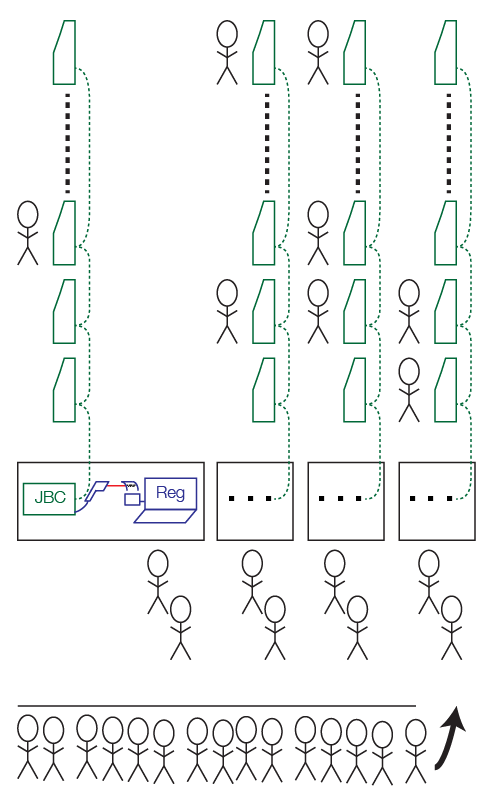(Or, why doing the obvious thing to improve voter throughput in Harris County early voting would exacerbate a serious security vulnerability.)
I voted today, using one of the many early voting centers in my county. I waited roughly 35 minutes before reaching a voting machine. Roughly 1/3 of the 40 voting machines at the location were unused while I was watching, so I started thinking about how they could improve their efficiency. If you look at the attached diagram, you’ll see how the polling place is laid out. There are four strings of ten Hart InterCivic eSlate DRE (paperless electronic) voting machines, each connected to a single controller device (JBC) with a local network. These are coded green in the diagram. On the table next to it is a laptop computer, used for verifying voter registration. This has a printer which produces a 2D barcode on a sticker. This is placed on a big sheet of paper, the voter signs it, and then they use the 2D barcode scanner, attached to the JBC, to read the barcode. This is how the JBC knows what ballot style to issue to the voter, avoiding input error on the part of the poll workers. I’ve used the color blue to indicate all of the early voting machinery, not normally present on Election Day (when all of the voters arriving in a given precinct will get the same ballot style).

First, let’s look at this scheme from an efficiency perspective. The main queue has somebody at the end telling you which of the four desks to wait at. I was unlucky and ended up behind somebody who wasn’t actually registered to vote in my county. (They told her, based on her address, that she needs to vote in the adjacent county.) This took a long time. By the time I was checked through, which went quickly, as they only needed to swipe the magstripe on the back of my driver’s license, only one of the ten machines connected to my particular JBC was still in use. All the other machines in my group were idle.
You could improve the efficiency by separating the registration machines, which print the 2D barcodes, from the JBCs, which control the voting machines. To achieve higher utilization, you could add more registration desks and have the voters take those 2D barcodes with them as they go to the JBC that authorizes them to vote. (The JBC prints a 4-digit code on thermal paper. The voter then picks any eSlate and enters that code to get their proper ballot style.)
But what about the security of such a change? The registration computer, its 2D barcode printer, and the 2D barcode scanner are not part of the package that is subject to any Federal or State supervision. We didn’t look at this as part of the California Top-to-Bottom Review for Hart InterCivic equipment. So what’s going on here? The barcode scanner gun appears to be attached to one of the ports on the back of the JBC. Based on what we learned in the California study, the mostly likely thing going on here is that the 2D barcode encodes raw Hart network commands that tell the JBC what to do. This runs afoul of “issue 1” in the report (page 30). This suggests that an adversary could print out a 2D barcode that instructs the JBC (or any connected eSlate) to do a variety of bad things. In the present design, this adversary could work with a corrupt poll worker. If you tried to improve system throughput, as I suggested above, the adversary could be any voter who could substitute a different 2D barcode as they pass from the registration machine to the JBC.
Conclusion: the Hart InterCivic eSlate system, as used for early voting in Harris County, slows down voter throughput whenever there’s a delay at the registration desk. The obvious fixes for this raise unacceptable security risks. Even in its current configuration, it’s unlikely that the system meets the certification requirements of Texas and other states’ laws, due to the uncertified use of the 2D barcode scanner attached to the JBC and its potential use as an attack vector.


Leave a Reply